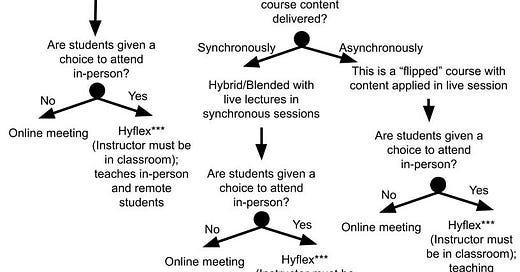While many headlines are touting “post-pandemic,” some may have realized that the pandemic isn’t over. Much like the mayor in Jaws touting that the beach is open, others moved on a long time ago (but we’ll ignore them for now, just as they ignore the health and safety of everyone else).
The sudden shift to remote instruction in the spring semester of 2020 brought a new level of attention to online teaching and learning and the associated terms.
I’ve written about the 2020 teaching shift before. Check out The One with the Pivot for a Friends (the tv series)-based look at the rapid teaching shift in spring 2020.
At this point of the (actually still going on) pandemic, terms surrounding teaching and learning are still being thrown around casually. Most of the time, it seems like the users aren’t quite sure how to apply the terms correctly.
In an effort to illustrate, I made a decision tree to show the complexity of potential content delivery methods and combinations. Definitions for these terms are explained after the tree. Disclaimer: this shows a few options and is not at all inclusive of all potential combinations and terms related to online teaching.
Image: Decision tree for online education terms, including synchronous/asynchronous for both meetings and main content delivery, options for joining, and similar. This decision tree is limited based on these options and not inclusive of all related online teaching terms. (Image: R. Yoho, 2021)
To accompany the unfortunately oversimplified decision tree above, I made a quick guide (with examples!) to some of the common terms and how they are often combined:
Asynchronous - students engage with the content at their own pace. Typically, this is characterized by reading materials and recorded video lectures. For “online” teaching, there are many benefits to choosing asynchronous. These include flexibility (for the students and instructor), less demanding internet bandwidth needs, fewer distractions or competition for attention at the time, and greater autonomy. However, many students resist asynchronous learning, even with the recorded lectures. Students (and some instructors) also prefer including synchronous sessions, as it’s easier to build community and a sense of belonging during the scheduled meeting times.
Blended - characterized by a mix of both live (or face-to-face) meeting sessions and online content (recorded lectures, readings, activities other than homework). Blended classes have synchronous sessions that are supplemented by online content.
Flipped - includes both synchronous (in-person or technology-based) and asynchronous activities, but the approach focuses on learning the basics outside of class (before, or occasionally, after) and applying the knowledge in the synchronous session.
Fully online - any class or educational activity without an in-person component. This may or may not have live, scheduled meetings.
Hybrid - (sometimes called “blended”) swap out some of the in-person instruction for online components. The amount of the course content varies widely. There are also multiple models for how hybrid courses are oriented:
Face-to-face centered - lectures and discussion are face-to-face and the, often collaborative, activities are online and asynchronous (more discussion and interaction for students)
Online centered - Recorded lectures are available for students, then in-person activities are discussion-based, project-based learning, or similar.
Lab centered - a variation of online-centered where the content is delivered online, asynchronously and the in-person activities are lab activities. Another potential variation includes online labs.
Flex design - The early part of the course includes face-to-face work with later weeks online and occasional check-ins. This is common for teacher training programs, internships, research experiences, and similar field work.
Hyflex - combining “hybrid” and “flexible,” hyflex is characterized by both synchronous and asynchronous components with students having the choice (the “flexible”) part to determine how they participate. In practice, this means that students typically choose whether or not they attend the synchronous class session in-person or remotely (via Zoom). The instructor is responsible for both the students in the physical classroom and virtual space simultaneously and does not have a choice to attend remotely.
Online education - generally, any form of education or learning where the connection is via the internet.
Synchronous - the students and instructor are together at the same place at the same time. This can be in person when everyone is in the classroom or via Zoom (Skype, etc.) when there is a scheduled virtual meeting time.
The combination of terms is where much of the confusion arises. An example of the combination of terms would be one of my fall classes, a hybrid/blended course flipped with asynchronous recorded lectures and online synchronous meetings. Using the definitions above, another correct description would be an “online-centered, flipped hybrid course.” This is not a hyflex course, so everyone met and was expected to meet online, including me as the professor. That means this course included weekly recorded lectures for the core course content that students viewed at their convenience during the week and joined synchronous meetings via Zoom. The Zoom sessions were used to apply course content, bring in guest speakers, do group activities, and work on projects.
Overall, the key with these terms is being as descriptive as possible to convey meaning. This usually ends with less of a term to describe a course and more of a long, descriptive sentence.
I’m excited to announce that the course described above (the “hybrid/blended course with asynchronous recorded lectures and online synchronous meetings”), called Climate Change, the Environment, and the Future of Public Health, just received the Exemplary Course designation from UF+Quality Matters, the highest possible course award in the statewide university system!
Online teaching terms have been around for a while. Now that more people are bandying about these words, hopefully this decision tree and discussion are a first step to making these conversations easier. And, hey, simply switching course meetings from in-person to meeting remotely does not make the course “online education.” It means the class met remotely. Typically, to save lives.




